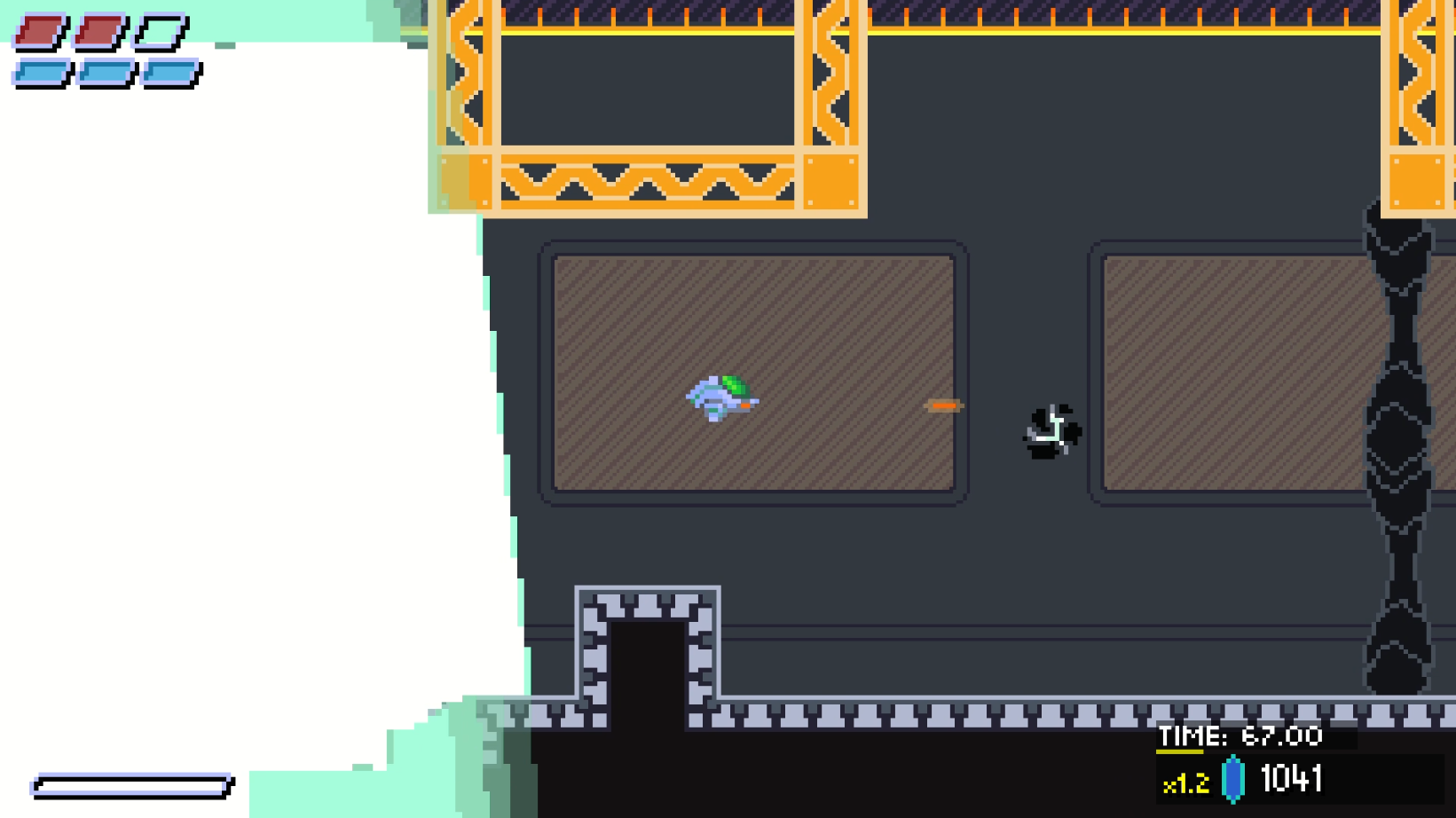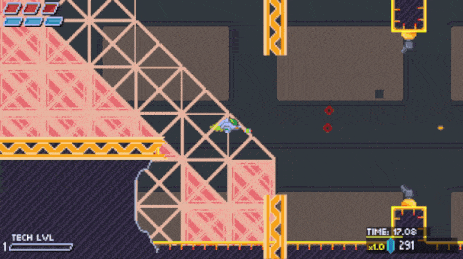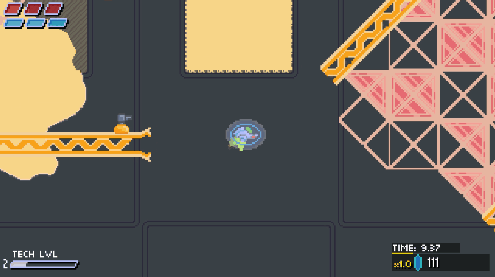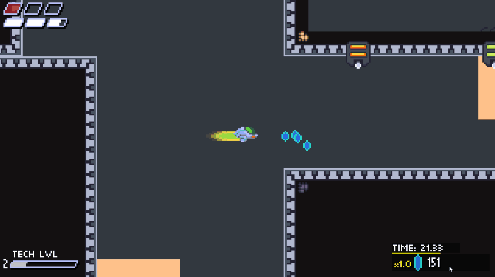Playtesting 2 - Still hard, now fun
This past July, I brought Chrono Blazer to the monthly Full Indie event in Richmond, BC and watched people play my game for the first time. I wrote about this experience, and although it was painful in some ways it gave me a lot of insight and has helped direct me in the intervening months.
Part of me didn't want to bring the game back in September. I had already missed the August meet up, because I wasn't feeling well that day. I'm not sure I would have brought the game even if I was healthy, or maybe I would have kept my laptop in a backpack and only brought it out by request.
I just felt like there wasn't enough stuff in the game, that people would see it all and say "that's it?"
However, my concern over the game coming across undercooked or too early or too sparse in content was being overridden by something else. I knew just how valuable it was to see the game played by strangers back in July, how it changed my approach to the game and led me to decisions I would have never reached otherwise. So, in September I brought Chrono Blazer back to Full Indie.
What was new?
Part of my response to the July feedback was to agonize over the design a little, try out a big new idea, scrap it, and then try out some smaller ideas.
I agonized over what to do about the player's progression. As I write this I realize I've never written about the design in much detail, so here's a bit of a breakdown:
- The player collects a currency to buy upgrades for their ship. The most basic are things that improve damage output and movement speed. There are also new abilities, and in the past month or so I've added consumable items.
- Not all upgrades are available at once. The player also has a Tech Level, and reaching the next Tech Level will unlock more things to buy for the ship.
- The Tech Level is upgraded by shooting and destroying an object in the game called an Anomaly. Anomalies do not respawn and appear scattered throughout the world. I plan for bosses to also be a form of Anomaly that can fight you, making it clear to the player that killing a boss means you will get a big boost to your Tech Level progress, and that killing a boss is permanent.
During the previous playtest, people saw Anomalies and shot at them. They take a few hits though, so when players didn't take them out immediately they'd usually move on. Unthreatening little ball, jiggling in place, while a giant wall of death is closing in. Easy choice.
I had a lot of thoughts about what to do about this, including completely redesigning the progression system, and decided on a fairly simple solution instead. Anomalies now have a wall associated with them, so each time you see an Anomaly there is also a similar looking wall beside it. This stops the player from simply blowing past the anomaly, and also introduces a mechanic that I think has some meat on it. Early on, anomalies will be obvious and directly in the player's path, near the wall associated with them. But later on, I can put the walls in and then hide the Anomaly and players will know they need to seek it out.

Aside from the lack of leveling up I saw at the first playtest, it was also clear the game was generally much too hard. I immediately, live at the venue, started tweaking values to make things easier. I reduced firing speeds for enemies, reduced how fast the death wall catches up to you, reduced the number of enemies in some areas. In the intervening weeks, I undid a lot of these changes. The game didn't need to be easy moment to moment, the player just needed the right tools to overcome the challenge.
One tool I experimented heavily with was a rewind mechanic. I did some research into how to do this in Game Maker, and was relieved and excited to find it broken down quite clearly in a forum post. I had to make some changes to get it working, and even once I "got it" there was a lot of busy work involved (every object needed fairly significant edits to account for a rewind mechanic). Ultimately though, I felt it ran counter to the game design. I want players to die often, buy upgrades and retry. A rewind mechanic lets them retry where they stand, and I think the brisk loop I want is completely lost. I do, however, think this could be a great mechanic to introduce late in the game to switch things up. So it's not quite dead yet.
I ended up introducing the concept of items instead. I implemented two items - the Shield and the Stasis Bomb.
The Stasis bomb was the harder of the two to implement, both in terms of design and technical considerations. I messed around a lot with what it looks like, how the player uses it, and how it affects enemies. What I landed on is a little bomb that shoots out in front of the player, explodes into a large circle, and every enemy caught in that circle is frozen briefly. It looks like this:

The Shield was fairly straight forward. It was weirdly hard to get the sprite to look right, something I thought was going to be extremely simple. I had known for a long time I wanted a Shield item and that it should enter a "deactivation" state when the player is hit, in which it remains active for a few more seconds but it's clear it's about to go away. Luckily, this general concept works and felt good right away. It begins deactivation after one hit, but after that one hit you can take several more hits as it is deactivating. It looks like this:

During the last playtest, I had electrical hazards in one area. I had built the area hastily the day of the playtest, wanting two paths to be available. I decided to theme the area around the electrical hazard, which is something I had created months before that but never really built gameplay around. It had issues, most of which was not having a proper tell. Lots of people got hung up on them. Rather than improve the electrical hazard (something I still want to go back and do), I added a new type of hazard to theme the area around - Proximity Doors. These doors begin to close when you come near, requiring the player to use their Boost ability to get through. They look like this:

I also made various tweaks to the level design, fixed some egregious bugs (big ones being the camera failing to follow the player properly in specific situations and the store UI becoming unresponsive), adjusted the store economy and progression (and added text to the items saying what "type" they are - item, upgrade, new ability), a little bit of level art (some areas looked quite rough last time), added new level content, improved some of the enemies, and added a health upgrade to the store.
The items are cheaper than upgrades and new abilities, and the health upgrade is the most expensive thing in the store by a wide margin. I felt it was important to have cheap expendable items that the player has to buy continuously, as well as something expensive to aspire toward.
I also updated the music in the Shop, with a song provided by my audio partner Juan months ago but never implemented by me (it ultimately took about 5 minutes).
Playtesting
Full Indie used to take place in bars in downtown Vancouver or the front lobby of Vancouver Film School. As of a few months ago, it takes place at The Gaming Stadium in Richmond, a suburb of Vancouver (known as the home of Vancouver International Airport and some of the most amazing Chinese food you can find in North America). The Gaming Stadium, at least the part of it used for Full Indie, is a big room with a projector screen and a bunch of gaming setups scattered around. I chose a desk, moved the keyboard and mouse out of the way, and plopped down my laptop with an Xbox controller and headphones attached.
Someone came by to try it out almost immediately, and from there I had observers who would jump in one after the other in fairly quick succession. I was nervous, but did my best to manage it. As people played, my nerves melted away. The game still has some rough edges, but it's fun!
Everyone that played, even people who said they "don't usually like this kind of game" or are "bad at games" kept playing for a while. They'd retry hard sections over and over, saving their currency to buy that next upgrade that's just out of reach. I had several comments along the lines of "I want to keep playing but I'll let someone else try". Some of this comes down to being respectful and polite during what is partially a networking opportunity. But last time, I could see people's frustrations more clearly. I could tell some people just didn't "get" the game. There was none of that this time.
The game is still a bit too hard. I talked about this a lot with people playtesting, and actually got some comments like "don't make it easier, I just need to get better." But I think the store economy is still a little off, some of the enemy placements are a little bit unfair to players, and collision on the player character could be more forgiving (I had made it a little forgiving already, but noticed people hitting things they thought they shouldn't). I ultimately didn't need to worry about lack of content because nobody was seeing it all anyway (except the one guy that did, a repeat player from last time).
Items were interesting, because people bought them but they didn't really use them. Or they'd try them once but never again. I think I'll lean toward making them even cheaper, so they're almost a no-brainer to try at least once and see what they're about. They both have a bit of a learning curve, so I could see their cost during this playtest (roughly half the cost of a permanent upgrade) being too steep. The health upgrade was great though - it meant that even when the store was otherwise completely bought out, playtesters had that extra little carrot on the stick to work toward.
The Anomaly wall was practically a non-factor, since I put Anomalies near the ends of the two main paths and hardly anyone got there. There are also a handful of "hidden" ones, but nobody noticed those either. And when people did reach the main Anomalies, they were so flustered (suddenly at a wall when trying to make forward progress and survive) that they didn't really know what to do. So, I think I'll put one in an easy spot close to the player's initial spawn. I still think the idea is solid, players just need the opportunity to learn. I told the one repeat player what to do when he reached one of them and almost destroyed it before decided to try ramming straight into the wall instead. He then collected two and became the only person to reach Tech Level 2, which unlocks the "Flux Orbs" (two powerful balls that fire diagonally) and Boost abilities for purchase as well as new levels of everything else.
I am thinking of trying out giving a small bit of Tech Level "experience points" every time an enemy is defeated. I had wanted the prospect of leveling up to be a huge driving factor in exploring the world, making progress and finding new Anomalies/bosses to defeat, so in a way this flies in the face of that a little. I just think it kind of sucks to have this progress bar that never fills until you find a very specific item. I'll see how it goes. I still think some narrative would go a long way to explaining to players what they should be doing and how the systems work, and that's very much not in the game yet.
Proximity Doors were kind of confusing to people, because nobody had the Boost ability yet. It might be fine. Maybe the "ah-ha!" moment is worth it. But I think I'll adjust how I introduce them, maybe bring back the electricity hazard again and make some needed improvements to it (like a tell before it activates, and a consistent pattern instead of a custom pattern on each instance).
What comes next?
I think the game is in a good place to make some tweaks and adjustments, and then bring back for more playtesting in October! I'll plug away at more content and the improvements mentioned above. I also had some art-minded players give me some feedback on backgrounds, which I want to try to implement to some extent (mainly to make the game as readable as possible).
I'm feeling good about the project right now. I do want to integrate narrative in the near future, and I want to have checkpoints and bosses in this game at some point too. My goal is still to have something closer to a "demo" early in 2024.
Chronoblazer
Blast, upgrade and explore as you master a time loop to save the future in this action-adventure shoot-em-up!
| Status | In development |
| Author | adammcdonald |
| Genre | Action, Adventure, Shooter |
| Tags | Boss battle, Metroidvania, Pixel Art, Shoot 'Em Up, Side Scroller, stg, Time Travel, upgrades |
More posts
- Narrative BalanceOct 27, 2024
- Summer 2024 Progress UpdateSep 24, 2024
- May 2024 Update - Boss fight, map and moreMay 04, 2024
- April 2024 UpdateApr 12, 2024
- March 2024 UpdateMar 10, 2024
- February 2024 updateFeb 04, 2024
- Getting StartedDec 19, 2023
- Inspiration - Part 2Aug 03, 2023
- Inspiration - Part 1Jul 27, 2023
Leave a comment
Log in with itch.io to leave a comment.